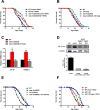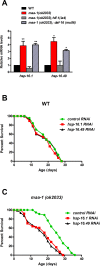HIF-1-dependent regulation of lifespan in Caenorhabditis elegans by the acyl-CoA-binding protein MAA-1
- PMID: 28758895
- PMCID: PMC5559173
- DOI: 10.18632/aging.101267
HIF-1-dependent regulation of lifespan in Caenorhabditis elegans by the acyl-CoA-binding protein MAA-1
Abstract
In yeast, the broadly conserved acyl-CoA-binding protein (ACBP) is a negative regulator of stress resistance and longevity. Here, we have turned to the nematode C. elegans as a model organism in which to determine whether ACBPs play similar roles in multicellular organisms. We systematically inactivated each of the seven C. elegans ACBP paralogs and found that one of them, maa-1 (which encodes membrane-associated ACBP 1), is indeed involved in the regulation of longevity. In fact, loss of maa-1 promotes lifespan extension and resistance to different types of stress. Through genetic and gene expression studies we have demonstrated that HIF-1, a master transcriptional regulator of adaptation to hypoxia, plays a central role in orchestrating the anti-aging response induced by MAA-1 deficiency. This response relies on the activation of molecular chaperones known to contribute to maintenance of the proteome. Our work extends to C. elegans the role of ACBP in aging, implicates HIF-1 in the increase of lifespan of maa-1-deficient worms, and sheds light on the anti-aging function of HIF-1. Given that both ACBP and HIF-1 are highly conserved, our results suggest the possible involvement of these proteins in the age-associated decline in proteostasis in mammals.
Keywords: ACBP; C. elegans; HIF-1; aging; proteostasis.
Conflict of interest statement
The authors have no conflict of interests to declare.
Figures






Similar articles
-
HIF-1 modulates dietary restriction-mediated lifespan extension via IRE-1 in Caenorhabditis elegans.PLoS Genet. 2009 May;5(5):e1000486. doi: 10.1371/journal.pgen.1000486. Epub 2009 May 22. PLoS Genet. 2009. PMID: 19461873 Free PMC article.
-
Homeodomain-interacting protein kinase maintains neuronal homeostasis during normal Caenorhabditis elegans aging and systemically regulates longevity from serotonergic and GABAergic neurons.Elife. 2023 Jun 20;12:e85792. doi: 10.7554/eLife.85792. Elife. 2023. PMID: 37338980 Free PMC article.
-
MAA-1, a novel acyl-CoA-binding protein involved in endosomal vesicle transport in Caenorhabditis elegans.Mol Biol Cell. 2006 Oct;17(10):4318-29. doi: 10.1091/mbc.e06-01-0035. Epub 2006 Jul 26. Mol Biol Cell. 2006. PMID: 16870706 Free PMC article.
-
Regulation of life span by mitochondrial respiration: the HIF-1 and ROS connection.Aging (Albany NY). 2011 Mar;3(3):304-10. doi: 10.18632/aging.100292. Aging (Albany NY). 2011. PMID: 21389351 Free PMC article. Review.
-
The hypoxia-inducible factor HIF-1 functions as both a positive and negative modulator of aging.Biol Chem. 2010 Oct;391(10):1131-7. doi: 10.1515/BC.2010.123. Biol Chem. 2010. PMID: 20707608 Free PMC article. Review.
Cited by
-
Plant Acyl-CoA-Binding Proteins-Their Lipid and Protein Interactors in Abiotic and Biotic Stresses.Cells. 2021 Apr 30;10(5):1064. doi: 10.3390/cells10051064. Cells. 2021. PMID: 33946260 Free PMC article. Review.
-
Emerging topics in C. elegans aging research: Transcriptional regulation, stress response and epigenetics.Mech Ageing Dev. 2019 Jan;177:4-21. doi: 10.1016/j.mad.2018.08.001. Epub 2018 Aug 19. Mech Ageing Dev. 2019. PMID: 30134144 Free PMC article. Review.
-
Transcriptome analyses describe the consequences of persistent HIF-1 over-activation in Caenorhabditis elegans.PLoS One. 2024 Mar 22;19(3):e0295093. doi: 10.1371/journal.pone.0295093. eCollection 2024. PLoS One. 2024. PMID: 38517909 Free PMC article.
-
Differential Stabilities of Mefloquine-Bound Human and Plasmodium falciparum Acyl-CoA-Binding Proteins.ACS Omega. 2021 Jan 11;6(3):1883-1893. doi: 10.1021/acsomega.0c04582. eCollection 2021 Jan 26. ACS Omega. 2021. PMID: 33521428 Free PMC article.
-
ACBP/DBI protein neutralization confers autophagy-dependent organ protection through inhibition of cell loss, inflammation, and fibrosis.Proc Natl Acad Sci U S A. 2022 Oct 11;119(41):e2207344119. doi: 10.1073/pnas.2207344119. Epub 2022 Oct 3. Proc Natl Acad Sci U S A. 2022. PMID: 36191214 Free PMC article.
References
-
- Fontana L, Partridge L, Longo VD. Extending healthy life span--from yeast to humans. Science. 2010;328:321–26. https://doi.org/10.1126/science.1172539 - DOI - PMC - PubMed
-
- Fabrizio P, Hoon S, Shamalnasab M, Galbani A, Wei M, Giaever G, Nislow C, Longo VD. Genome-wide screen in Saccharomyces cerevisiae identifies vacuolar protein sorting, autophagy, biosynthetic, and tRNA methylation genes involved in life span regulation. PLoS Genet. 2010;6:e1001024. https://doi.org/10.1371/journal.pgen.1001024 - DOI - PMC - PubMed
-
- Burton M, Rose TM, Faergeman NJ, Knudsen J. Evolution of the acyl-CoA binding protein (ACBP) Biochem J. 2005;392:299–307. https://doi.org/10.1042/BJ20050664 - DOI - PMC - PubMed
-
- Knudsen J, Jensen MV, Hansen JK, Faergeman NJ, Neergaard TB, Gaigg B. Role of acylCoA binding protein in acylCoA transport, metabolism and cell signaling. Mol Cell Biochem. 1999;192:95–103. https://doi.org/10.1023/A:1006830606060 - DOI - PubMed
-
- Gaigg B, Neergaard TB, Schneiter R, Hansen JK, Faergeman NJ, Jensen NA, Andersen JR, Friis J, Sandhoff R, Schrøder HD, Knudsen J. Depletion of acyl-coenzyme A-binding protein affects sphingolipid synthesis and causes vesicle accumulation and membrane defects in Saccharomyces cerevisiae. Mol Biol Cell. 2001;12:1147–60. https://doi.org/10.1091/mbc.12.4.1147 - DOI - PMC - PubMed
Publication types
MeSH terms
Substances
Grants and funding
LinkOut - more resources
Full Text Sources
Other Literature Sources

